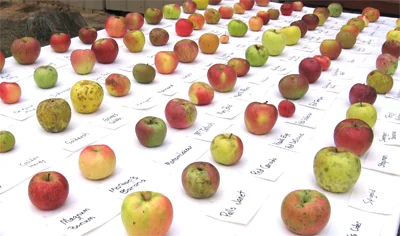How to Choose Apple Tree Varieties To Grow and Eat
“Why do we need so many kinds of apples? Because there are so many folks. A person has a right to gratify his legitimate taste. If he wants twenty or forty kinds of apples for his personal use…he should be accorded the privilege. There is merit in variety itself. It provides more contact with life, and leads away from uniformity and monotony.” — Liberty Hyde Baily
Liberty Hyde Baily’s quote above, said it best, variety is indeed the spice of life. In case you aren’t familiar with him, he was an American horticulturist, botanist, and cofounder of the American Society for Horticultural Science.
Supermarket apple varieties to choose from - Source: Abrahami, Creative Commons Wikimedia Commons
There once was a time in our country when over sixteen thousand different apple tree varieties existed, an amazing feat considering that apples are not native to the American continent. Sadly today, it is believed that only less than three thousand apple varieties are still known and available both for eating and for growing. Yes, it’s true apple trees are among the endangered trees in our nation.
This is in part because of urban sprawl, part because of the average gardener not being aware of the importance of keeping heirloom apple varieties alive, and due to the demise of the honey bees in the last few years. There is also a growing fear that if we don’t pay attention to the plight of the honeybee, the apple will become something as rare and expensive as the price of gold. I know that seems impossible, but it’s true.
Apples on the tree
There are apple varieties and then there are apple varieties. Chances are if you were to walk into any grocery store in the United States, you would encounter a Red Delicious Apple in the fruits and vegetables section. That’s because over 40% of all apples sold are of this variety. Even more shocking, is the fact the over ninety percent of the other apples you’ll come across (both in the grocery and the nursery) will consist of only less than a dozen of apple tree varieties. However, what most people planting apple trees will not know, is that they personally are contributing to the demise of apple tree varieties.
Apples in Rouse's Grocery Store, New Orleans - Source: Infrogmation of New Orleans, Creative Commons via Wikimedia Commons
How can this be? Up until fairly recently there were a lot of commercial apple tree growers whose livelihood has been replaced by big commercial operations that sell their apple trees at big box stores and garden-lawn stores. It simply doesn’t occur to most buyers of apple trees, especially for the home apple orchard, that they might be better off purchasing an heirloom apple tree variety and therefore seek to buy from the small orchard tree farmer who may have heirloom varieties.
Adding to the apple tree variety problem is also a loss of general knowledge among our population in growing fruit trees. In our grandmother’s day, there were many people who actually knew how to select the right apple variety for their location; understood how to graft apple scions onto rootstock to create new varieties; understood the nuances of apples and the importance in harvest times for best flavor; and had enough knowledge about the storage and preparation of apples to know what apple tree variety was best for what recipe.
So before going out to buy that apple tree, let’s look at some of the different apple tree varieties. If you are limited to purchasing your apple tree for planting to the local big box nursery or home improvement store, chances are you will encounter:
Tree Town USA - Red Delicious Apple
Fuji Apple
Empire Apple
Gala Apple
Golden Delicious Apple
Granny Smith Apple
However, if you want an heirloom apple tree and want to think outside the apple box, here are some other apple tree variety suggestions:
Alexander - (also known as the grand Alexander) a Russian apple tree that was in this county before 1817
Allington Pippin - This heirloom apple that arrived in the late 1890s from the United Kingdom.
Arkansas Black - It was planted first in 1886. Unique in appearance since it is a dark purply red to black its a very precious heirloom apple.
Baldwin - A Massachusetts apple variety that showed up in 1784.
Blue Pearmain New England Early 1800s – perfect for making cider
Bramley’s Seedling 1813 – A favorite among English for making apple sauces
Calville Rouge D’Automne – French sweet apple
Dorsett Golden Bahamas – Perfect apple tree to plant in warm climates
Golden Nugget Nova Scotia – Excellent sweet flavor even though it is small
Hauer Pippin California – Best choice if you want an apple that keeps well (on or off tree)
Holstein Germany 1918 – Favorite dessert apple
Maigold Switzerland 1944 – Small but tasty
Pink Lady Western Australia – Perfect apple tree for hot climates
Pink Sparkle (aka Pink Pearmain) – The inside is as pink as the outside, makes a lovely sorbet or unusual dessert apple
Red Astrachan Russian 1816 (via England) – Top pie apple in your great-grandmother’s day
Reinette Du Canada France prior to 1771 – One apple variety mentioned in my Acadian family’s recipes for apple tarts
Strawberry Parfait – New Jersey – good early apple variety
Winter Banana Indiana – one of the top eating apples
If You'd Like To Purchase Heirloom Apple Trees!




